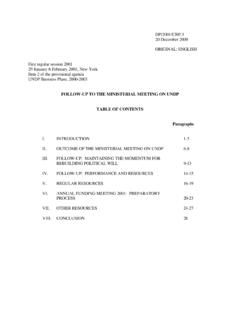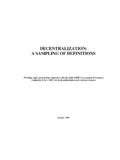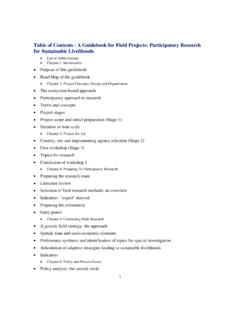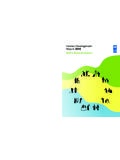Transcription of the table of contents - energizeinc.com
1 1 THE partnering CHALLENGE THE RATIONALE FOR PARTNERINGOBSTACLES TO partnering KEY partnering PRINCIPLESTHE LEADERSHIP CHALLENGE2 BUILDING PARTNERSHIPSIDENTIFYING PARTNERSASSESSING RISKS & REWARDSRESOURCE MAPPING3 partnering AGREEMENTSSECURING PARTNER COMMITMENT INTEREST-BASED NEGOTIATION GOVERNANCE AND ACCOUNTABILITY 4 MANAGING THE partnering PROCESSPARTNERING ROLESPARTNERS AS LEADERS partnering SKILLS GOOD partnering PRACTICE5 DELIVERING SUCCESSFUL PROJECTS MANAGING THE TRANSITIONKEEPING TO THE TASKREPORTING, REVIEWING & REVISING 6 SUSTAINING PARTNERSHIPSPLANNING FOR THE LONGER-TERMSECURING GREATER ENGAGEMENTBUILDING INSTITUTIONAL CAPACITY7 SUCCESSFUL PARTNERINGDEFINING SUCCESSSHARING GOOD EXPERIENCESCOLLABORATION IN A COMPETITIVE WORLDI ndexof tools1 PARTNER ASSESSMENT FORM2 COHERENCE ASSESSMENT QUESTIONNAIRE3 SAMPLE partnering AGREEMENT4 partnering ROLES AND SKILLS QUESTIONNAIRE5 GUIDELINES FOR partnering CONVERSATIONS6 PARTNERSHIP REVIEW TEMPLATE7 CASE STUDY TEMPLATE8 COMMUNICATIONS CHECK LIST table of contentsTHE partnering toolbook has been produced in co-operation with the following partner organisations.
2 GAINThe Global Alliance for Improved Nutrition (GAIN) is a global and regional alliance ofpublic, private and civil society partners committed to eliminating vitamin andmineral deficiencies. By 2007, GAIN aims to have contributed to the improvednutritional status of at least 600 million people in up to 40 developing countries,primarily through facilitating fortification of commonly available and consumed localfoods. GAIN also aims to energise and harmonise the work of governments, bilateraldonors, UN agencies, the private sector as well as public health and developmentorganisations working to reduce micronutrient information: united nations development programme ( undp ) is the UN's global developmentnetwork, advocating for change and connecting countries to knowledge, experienceand resources to help people build better lives.
3 undp is active in 166 countries,working with them on developing and implementing their own solutions to global andnational development challenges. World leaders have pledged to achieve theMillennium development Goals, including the overarching goal of cutting poverty inhalf by 2015. undp 's network links and coordinates global and national efforts toreach these information: International Atomic Energy Agency (IAEA) is the global focal point for nuclearcooperation within the united nations family. Its programme , dedicated to helping itsMember States achieve their social and economic goals, is focused on many activitiesthat serve basic human needs by applying nuclear science to improve health care(nutrition, cancer treatment, communicable diseases etc.)
4 , increase food production,improve management of water resources and assess sources of environmentalpollution. More information: Prince of Wales International Business Leaders Forum (IBLF) is a not for profitorganisation established in 1990 to promote responsible business practices thatbenefit business and society and contribute to sustainable development . The IBLF believes that business has a significant role to play in addressing the downsides ofglobalisation: poverty, social inequity and environmental degradation. With amembership of over 80 companies from around the world, the IBLF works at strategiclevels as well as in developing / transitional countries.
5 IBLF has established aninternational reputation in its cutting edge cross-sector partnership building information: by: Ros Tennyson, Partnership Specialist and Director of Learning Programmes, International Business Leaders ForumContent editor: Barbara TorgglerTechnical editor: Anna HillCover design: Alison BeanlandCartoons: Guy VenablesDesign and Print: number: 1899159 08 8 Copyright: 2003. The International Business Leaders Forum (IBLF) and the Global Alliance for Improved Nutrition (GAIN)This publication is in three parts:Part l is a short book that describes the generic partnering process from inception to conclusion. Part 2 is in the form of stand alone tools to enable practitioners to develop effective partnerships.
6 Part 3 includes more information about GAIN, the issues around food fortification and case studies selected to be locally appropriate for each of the different language views and ideas expressed in this publication are those of the author and the additional named contributors (see inside back cover).ReferencesThe partnering toolbook has drawn on material from three earlier publications: Managing Partnerships: Tools for Mobilising the Public Sector, Business and Civil Society as Partners in development , Ros TennysonPublished: The Prince of Wales Business Leaders Forum, 1998 The Guiding Hand: Brokering Partnerships for Sustainable development , Ros Tennyson and Luke WildePublished: united nations Office of Public Information, 2000 Institutionalising Partnerships: Lessons from the Front Line, Ros Tennyson Published: International Business Leaders Forum, 2003 Further inspiration has come from: The Way of Being Free, Ben OkriPublished.
7 Phoenix A Brief History of Everything, Ken WilberPublished: Shambhala Publications, material builds on the experience of many practitioners from all over the world, but particular thanks are due to Michael Jacobs for writing Box 7: Telling the Story, to Alain Gaultier for compiling Tool 2 and to Barbara Torggler for her invaluable editing work on the whole text as well as her and undp s specific in-puts into Chapter 4 and Tool author gratefully acknowledges the invaluable feedback from Dr. Soekirman and his colleagues of Koalisi Fortifikasi (Indonesia) and from Dr. Juan Rivera Dommarco, Director Ejecutivo del CINyS and Guadalupe Rodriguez (Mexico) as well as other GAIN Board Members and Partners in response to an early draft of this support for this project came from those present (60 people from 15 countries) at a GAIN workshop in Geneva in August 2003.
8 With their encouragement, a commitment was made to producing versions of The partnering toolbook in a number of other languages available in electronic intention is that this publication will reach a large number of (actual or aspiring) partnership practitioners by using the networks and dissemination channels of all the partner organisations. 1 THE partnering CHALLENGE THE RATIONALE FOR PARTNERINGOBSTACLES TO partnering KEY partnering PRINCIPLESTHE LEADERSHIP CHALLENGE2 BUILDING PARTNERSHIPSIDENTIFYING PARTNERSASSESSING RISKS & REWARDSRESOURCE MAPPING3 partnering AGREEMENTSSECURING PARTNER COMMITMENT INTEREST-BASED NEGOTIATION GOVERNANCE AND ACCOUNTABILITY 4 MANAGING THE partnering PROCESSPARTNERING ROLESPARTNERS AS LEADERS partnering SKILLS GOOD partnering PRACTICE5 DELIVERING SUCCESSFUL PROJECTS MANAGING THE TRANSITIONKEEPING TO THE TASKREPORTING.
9 REVIEWING & REVISING 6 SUSTAINING PARTNERSHIPSPLANNING FOR THE LONGER-TERMSECURING GREATER ENGAGEMENTBUILDING INSTITUTIONAL CAPACITY7 SUCCESSFUL PARTNERINGDEFINING SUCCESSSHARING GOOD EXPERIENCESCOLLABORATION IN A COMPETITIVE WORLDI ndexof tools1 PARTNER ASSESSMENT FORM2 COHERENCE ASSESSMENT QUESTIONNAIRE3 SAMPLE partnering AGREEMENT4 partnering ROLES AND SKILLS QUESTIONNAIRE5 GUIDELINES FOR partnering CONVERSATIONS6 PARTNERSHIP REVIEW TEMPLATE7 CASE STUDY TEMPLATE8 COMMUNICATIONS CHECK LIST table of contentsTHE partnering toolbook has been produced in co-operation with the following partner organisations:GAINThe Global Alliance for Improved Nutrition (GAIN) is a global and regional alliance ofpublic, private and civil society partners committed to eliminating vitamin andmineral deficiencies.
10 By 2007, GAIN aims to have contributed to the improvednutritional status of at least 600 million people in up to 40 developing countries,primarily through facilitating fortification of commonly available and consumed localfoods. GAIN also aims to energise and harmonise the work of governments, bilateraldonors, UN agencies, the private sector as well as public health and developmentorganisations working to reduce micronutrient information: united nations development programme ( undp ) is the UN's global developmentnetwork, advocating for change and connecting countries to knowledge, experienceand resources to help people build better lives.









